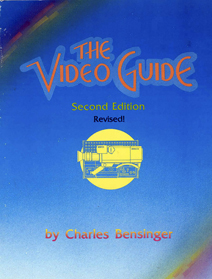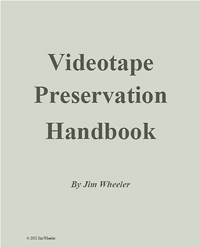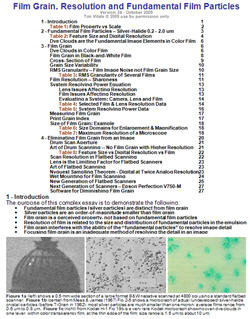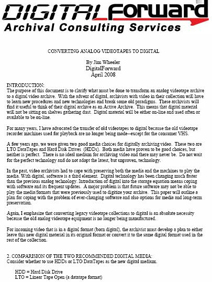Library of Video History, Science and Technology |
|
| The Video Guide | |
|
Charles Bensinger (1981) Full text and image set is online and completely searchable. The information is first rate and written in a highly accessible style; especially when compared to today's complex technical texts on video technology. There are a vast number of images and descriptions of historic VCR/VTRs, plug diagrams, and hookup diagrams. |
|
| Video Preservation Resources | |
Videotape Preservation Handbook Jim Wheeler, 2002 located on the AMIA website under Publication and Resources Jim Wheeler is one the great resources on magnetic media, retired from Ampex, he is still active on AMIA-L, preserving magnetic tape and with preservation initiatives. |
|
 |
Edited by Hannah Frost, continually updated. A key resource for the preservation of video with a wide variety of publications, links and resources. |
 |
AMIA Video Preservation Fact Sheets Written by Jim Wheeler; Edited by Hannah Frost, 2004-5 -- now as a 42-pg PDF on amianet.org -- A valuable resource by one of the best know workers in the field (retired Ampex), with excellent editing (Stanford Univ. Preservation Librarian) making the information even more valuable . |
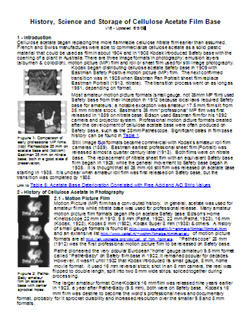 |
History, Science and Storage of Cellulose Acetate Film Base
Tim Vitale, v16b, revised June 2009
Includes information on video tape that uses cellulose acetate carrier as part of the tape. Cold storage is the preferred solution, but at temperatures above freezing (35-40°F and above) as opposed to film, where colder is better. |
Brief History of Imaging Technology Tim Vitale, v28, completely reworked April 2013 The essay covers imaging technology over 5000 years: from polished stones through modern lenses; from light sensitive chemicals to acetate, nitrate and color film; includes discovering electricity through the first Fax, to analog video and digital still images. The preservation and storage of film and digital files is emphasized. The 5000-years-before-present (2009) time-line covers Lens History; Pre-Photography; Film Camera; B&W Photography; Color Photography; Digital Photography; Magnetic Media; Video Technology and Digital Printing Technolgy. The essay also shows the development from video technology to modern high-end single frame technology with reasons for the various technological branches. |
|
 |
Magnetic Tape Storage and HandlingA Guide for Libraries and ArchivesDr. John W.C. Van Bogart (National Media Laboratory) June 1995; Published by Commission on Preservation and Access; online version at <www.clir.org>. A valuable resource by one of the prominent workers in the field. |
Cold Storage of Cultural Artifacts Tim Vitale, v17, updated Oct. 2011 Extensive review and presentation of new work on the cold storage of cultural materials. The common recommenced range for working with all cultural material is 70°F +/- 10°F and 50% RH +/- 10% RH. If possible, working with artifacts at lower temperatures and relative humidity is desirable. Daily storage on the shelf in an unconditioned room at 85°F and 60% RH will lower their lifetime to 25% of storage at recommended "use" conditions. Cold storage of the original videotape at recommended conditions will prolong its life by 2-8 times depending on its current state of preservation. However, at the end of this period (20-100 years), playback equipment probably won't be readily available. |
|
 |
Cold Storage of Photographs at the City of Vancouver Archives
Sue Bigelow, Art Conservator
Unparalleled guide to cold storage in museums, libraries and archives. |
 |
Mark McCormick-Goodhart, Posted July 31, 2003 |
 |
Mark McCormick-Goodhart and Henry Wilhelm, Posted May 17, 2004 |
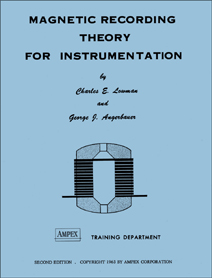 |
Magnetic Recording Theory for Instrumentation Ampex Corp. 1963 Charles Lowman and George Angerbauer This is one of the essential early publications on the theory and application of magnetic and videotape recording. It is invaluable historic resource and is a must read for all interested in the history of video recording. |
 |
LabGuy's World: The Birth of Video Recording Charles P. Ginsburg Charles P. Ginsburg first delivered this paper, in a slightly different form, at the 82nd convention of the Society of Motion Picture and Television Engineers (SMPTE) on October 5, 1957, 18 months after Ampex demonstrated the world's first practical television videotape recorder; transcribed by Jerry Burling, SBE, Chapter 47. |
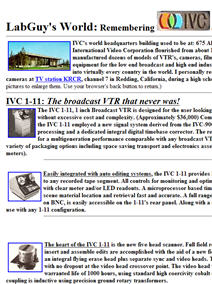 |
LabGuy's World: Remembering IVC (International Video Corporation)
|
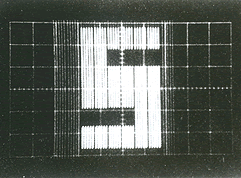 |
|
| Ochi's first 64 pixel CCD, 1972, displaying an "S" for Sony; image from Sony History URL. | |
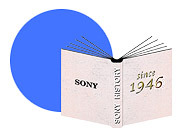 |
A general history of the Sony Corp., but with several very interesting entries on VTRs such as Sony's first experimental 2" VTR about 1958-59 and the first transistorized VTR PV-100 in 1959. |
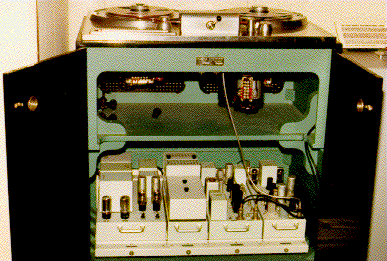 |
Chronology of Ampex Professional Products (Draft: 29 Oct 95; Rev. 4 Nov 99) Compiled by Howard Sanner Image: Ampex 200A VTR Serial No 003 |
Ampex Data Systems Website |
Ampex Legacy Equipment Manuals Mostly audio equipment circuit diagrams and images, but there are positions allocated for video equipment |
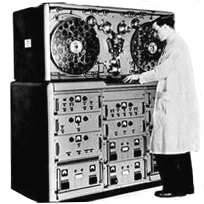 |
BBC- The History of Video Recording located on the <bbc.co.uk> website, along with BBC News' "The Rise and Rise of the Video" Puts Magnetophone (1936-7 Germany) BBC VERA (2" wide steel tape on 21" reels moving at 200 ips) and Ampex VR-1000 (2" plastic magnetic tape at 100 ips) in context, by one of the players in early video history. |
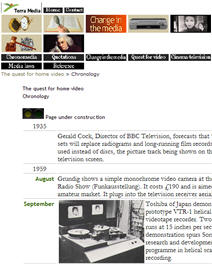 |
Terra Media's Chronology of Video Technology
This is a discrete section on Video Technology of the the larger Terre Media Chronomedia of technology from 1200 to the present. The chronology appears to skip the development of photographic equipment such as lenses, cameras and imaging media such as film and CCDs. within their large chronology of technology. |
| Technical Resources | |
 |
Bill Vermillion's Article on Tape Deck Alignment This interesting email is on audio deck alignment, linear recording tracks, but has generic application to VTR use. |
Estimating the Resolution of Historic Film Images: Using the Resolving PowerEquation (RPE) and Estimates of Lens QualityTim Vitale, v9 - Revised November 2009 Determining the resolution of an image in a specific piece of modern film has become common when the film type and taking-lens are known. Doing the same for images made before 1940 is complicated by the lack of information on native film resoution and lens quality. An estimate is provided. |
|
Film Grain, Resolution and Fundamental Film ParticlesTim Vitale, v24 - revised Oct. 2009
Review of film grain and fundimental particles in film. The effects of film grain and fundimantal image particles on image noise, resolution and digital scanning. |
|
 |
History, Science, Preservation and Storage of Cellulose Nitrate Film
Tim Vitale, v26, revised June 2009
Companion to the History, Science and Storage of Cellulose Acetate Film Base above. Cellulose nitrate was unlikely used in magnetic media except for experimental materials in the early days of developing tape carriers. Cellulose nitrate base will degrade in a minimum of 50-60 years, but has now been predicted to last up 500 years. Cold storage is the only tool to halt deterioration. |
Digital Image File Formats and their StorageTIFF, JPEG & JPEG2000Tim Vitale v 20 - updated April 2010 Storage of image information is crucial for its long-term preservation. Although digital images can be stored indefinitely without deterioration, they can be lost. A digital file can be permanently “lost” if it is stored without regard for basic computer technology or on inappropriate storage media. The recommended storage medium is the harddrive (HDD), which is viable for 5-10 years; see Section 6 “Storage” pages 35-39 for details. Although a HD can fail, it is usually backed up on another HD, or the files are stored in an internally redundant RAID array (mode 1 or 6, not 5). Optical media (CDR, DVD-R) fail without warning (3-25 yrs) and their (disk) readers probably won’t be available in 15-20 yrs |
|
| Digital Capture Resources | |
 |
Digital Video Preservation Reformatting Project -- Report
This is a valuable resource. Jim Lindner (Media Matters) address many issues including the cost of storage on data tape; the value of lossless compression; the damage of lossy compression; and the evaluation of video codecs based on both user viewing evaluations and the Genista’s Media Optimacy (Tokyo) technical metrics. "A chief goal of this report was to endorse a specific file format and codec to use for the preservation of dance material. Regarding file format, the Material Exchange Format (MXF) container format is recommended." |
Moving Beyond Manual Media Migration James Lindner and Gilad L. Rosner of Media Matters, LLC (SAMMA) Valuable essay on moving from traditional migration procedures to automated procedures. Especially valuable is the section on cleaning videotape. "Current cleaning machines are blunt and simple: they clean forward, and they clean backwards. In an attempt to reduce the potential for further damage, traditional migration companies pay a person to watch the cleaning tissue in the cleaning machine all day." |
|
Converting Analog Videotapes to Digital A very useful essay on the use and advantage of using hard drives (HDD) and data tape (LTO) for the storage of digitized analog video files.
|
|
Research Report on JPEG 2000 for Video Archiving Ian Gilmour, Media Matters LLC (SAMMA) Abstract: Motion-JPEG2000 lossless data reduction is implemented as a key technology for reducing file size in storage and for reducing data rates in networked file transfer. Specific quotes (8-bit vs 10-bit) " The 10-bit files were 47% to 58% larger than the 8-bit files, rather than the 25% increase which simple math would predict." and (Conclusions) "The range of image content in this preliminary study of lossless JPEG encoding has provided valuable data on file sizes which generally accords well with theoretical predictions..." |
|
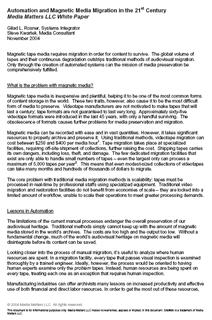 |
Automation and Magnetic Media Migration in the 21st Century Media Matters LLC (SAMMA) white paper: by Gilad L. Rosner, Systems Integrator Steve Kwartek, Media Consultant, 2004. A valuable modern resource describing the downsides of traditional migration procedures and costs. " Using traditional methods, videotape migration can cost between $250 and $400 per media hour. Tape migration takes place at specialized facilities, requiring off-site shipment of collections, further raising the cost. Shipping tapes carries its own dangers, including loss, theft, and damage." The need for lower cost procedures are emphasized. |
| AJA Video System Information | |
 |
Video capture card Installation and Operations Guide; for Mac systems. |
 |
Video capture card Installation and Operations Guide; for Mac systems. |
 |
Video capture card Installation and Operations Guide; for PC systems. |
Video capture using an external ADC device can be used with both Mac and PC systems.
|
|
 |
Installation and Operation Guide for video capture using an external ADC device.
|
 |
System overview for video capture using an internal PCI card. |
 |
For all Mac video capture systems: Kona 2, LH LS; Io, Io La and Io LD; Kona SD and HD. |
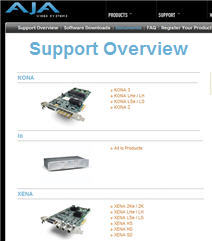 |
AJA Video Systems -- Support Portal Many support documents for specific products along with software tools for determining suitability of existing computers and the speed of internal HDs and external RAID HD arrays. In addition there are calculators to determine file size based on bit depth, frame size and format; along with codec translators and much more. |
| Blackmagic Design Information | |
 |
Blackmagic Design - Multibridge Extreme PC Version |
 |
Blackmagic Design - Multibridge Extreme Mac Version |
 |
|
 |
Blackmagic Design -- Support Library Blackmagic Design is is one of the manufacturers of video capture card and external ADC devices. In the following link their support page has been set-up for DeckLink Extreme. The library has hundreds of document that will help with designing a system and facilitate purchase of components. |
